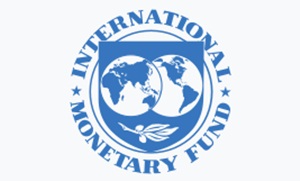The International Monetary Fund (IMF) has lowered its growth forecast for India for the fiscal year 2024-25 to 6.3 per cent from the earlier projection of 6.8 per cent made in January this year. The downward revision in the growth forecast is attributed to the recent surge in Covid-19 cases in India that has led to localised lockdowns and restrictions, affecting economic activity.

In its recently released World Economic Outlook report, the IMF also revised its forecast for India’s retail inflation to be at 4.9 per cent for the fiscal year 2023-24 and 4.4 per cent for the fiscal year 2024-25.
Despite a significant drop in growth rate projections from 6.8 per cent in 2022 to 5.9 per cent in 2023, the latest World Economic Outlook figures show that India continues to be the fastest-growing major economy in the world. IMF has projected China’s growth rate to be 5.2 per cent in 2023 and 4.5 per cent in 2024, against a growth rate of 3 per cent in 2022.
With the resurgence in Covid-19 pandemic, IMF has lowered its growth projections for the global economy as well, predicting a growth rate of 2.8 per cent this year and 3 per cent in 2024, down 10 basis points each from its January forecasts.
Stubbornly high inflation and recent financial sector turmoil have dimmed hopes that with benign inflation and steady growth the world economy could achieve a soft landing. Although inflation has declined with central banks raising interest rates and the decline in food and energy prices, the underlying price pressures are proving sticky, with labor markets tight in a number of economies. However, the fast rise in policy rates are leading to vulnerabilities in the banking sector, raising the spectre of contagion across the broader financial sector, including nonbank financial institutions, the report noted.
As stated in the Global Financial Stability Report, published earlier, financial conditions across the world are fluctuating with the shifts in sentiment. In parallel, the other major forces that shaped the world economy in 2022 seem set to continue into this year, but with changed intensities. Debt levels remain high, limiting the ability of fiscal policymakers to respond to new challenges. Commodity prices that rose sharply following Russia’s invasion of Ukraine have moderated, but the war continues, and geopolitical tensions are high. Infectious Covid-19 strains caused widespread outbreaks last year, but economies that were hit hard — most notably China — appear to be recovering, easing supply-chain disruptions.
Despite the fillips from lower food and energy prices and improved supply-chain functioning, risks are firmly to the downside with the increased uncertainty from the recent financial sector turmoil. The baseline forecast, which assumes that the recent financial sector stresses are contained, is for growth to fall from 3.4 per cent in 2022 to 2.8 per cent in 2023, before rising slowly and settling at 3.0 per cent five years out –– the lowest medium-term forecast in decades. Advanced economies are expected to see an especially pronounced growth slowdown, from 2.7 per cent in 2022 to 1.3 per cent in 2023. In a plausible alternative scenario with further financial sector stress, global growth will decline to about 2.5 per cent in 2023 –– the weakest growth since the global downturn of 2001, barring the initial Covid-19 crisis in 2020 and during the global financial crisis in 2009 –– with advanced economy growth falling below 1 per cent.
The IMF said anemic outlook reflects the tight policy stances needed to bring down inflation, the fallout from the recent deterioration in financial conditions, the ongoing war in Ukraine, and growing geoeconomic fragmentation. Global headline inflation is set to fall from 8.7 per cent in 2022 to 7.0 per cent in 2023 on the back of lower commodity prices, but underlying (core) inflation is likely to decline more slowly. Inflation’s return to target is unlikely before 2025 in most cases, the report stated adding that once inflation rates are back to targets, deeper structural drivers will likely reduce interest rates toward their pre-pandemic levels.
Risks to the outlook are heavily skewed to the downside, with the chances of a hard landing having risen sharply. Financial sector stress could amplify and contagion could take hold, weakening the real economy through a sharp deterioration in financing conditions and compelling central banks to reconsider their policy paths. Pockets of sovereign debt distress could, in the context of higher borrowing costs and lower growth, spread and become more systemic. The war in Ukraine could intensify and lead to more food and energy price spikes, pushing inflation up. Core inflation could turn out more persistent than anticipated, requiring even more monetary tightening to tame.
Fragmentation into geopolitical blocs has the scope to generate large output losses, including through its effects on foreign direct investment, says the report.
Policymakers have a narrow path to walk to improve prospects and minimise risks. Central banks need to remain steady with their tighter anti-inflation stance, but also be ready to adjust and use their full set of policy instruments — including to address financial stability concerns — as developments demand.
Fiscal policymakers should buttress monetary and financial policymakers’ actions in getting inflation back to target while maintaining financial stability.
IMF wants governments to aim for an overall tight stance while providing targeted support to those struggling most with the cost-of-living crisis. In a severe downside scenario, automatic stabilisers should be allowed to operate fully and temporary support measures be utilized as needed, fiscal space permitting.
Medium-term debt sustainability will require well-timed fiscal consolidation but also debt restructuring in some cases (Chapter 3). Currencies should be allowed to adjust to changing fundamentals, but deploying capital flow management policies on outflows may be warranted in crisis or imminent crisis circumstances, without substituting for needed macroeconomic policy adjustment. Measures to address structural factors impeding supply could ameliorate medium-term growth. Steps to strengthen multilateral cooperation are essential to make progress in creating a more resilient world economy, including by bolstering the global financial safety net, mitigating the costs of climate change, and reducing the adverse effects of geoeconomic fragmentation, says the report.























